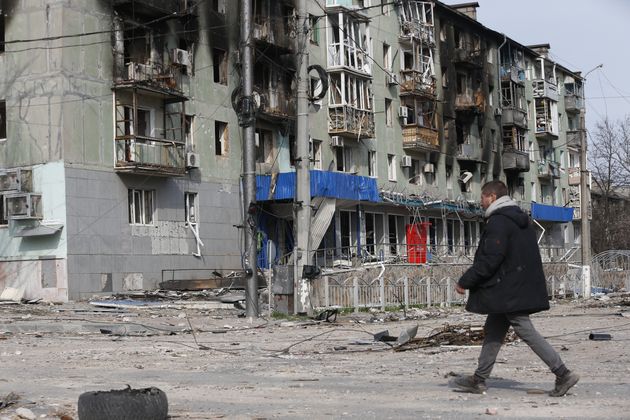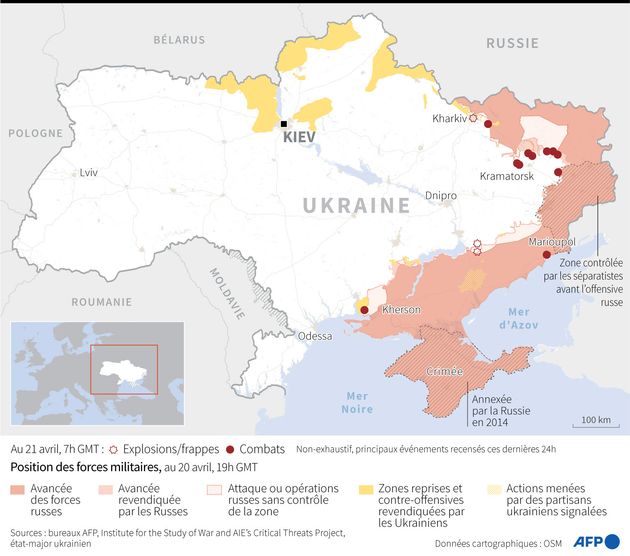Xinhua News Agency via Getty Images
WAR IN UKRANE – After nearly two months of siege, Russia announced on Thursday, April 21 the almost total control of Mariupol, strategic Ukrainian port. The conquest of this city deprives Ukraine of its access to the Sea of Azov. It mainly allows Russian troops to connect the Donbas to Crimea, annexed by the Kremlin in 2014, opening up several possibilities for Moscow.
With a string of setbacks since February 24, the date of the launch of the Russian invasion of Ukraine, Russia announced in late March that it would now target the east of the country. The Russian President Vladimir Poutine This Thursday achieved a first victory since this redeployment of Russian troops with the capture of Mariupol, which he says was “successfully” “liberated”. But this will not be the end of this war.
Intensification of attacks on Kharkiv
In Kharkiv and his region, which has been under attack by Russian forces since the beginning of two months, has heightened tension in recent days. Evidence that this city in the northeast of Ukraine is still one of the main targets of Moscow, as the battle for Mariupol despite the resistance of the last warriors entrenched on the Metallurgical site Azovstal†
“The situation is stressful because the night was marked by massive shelling,” said the mayor of Ukraine’s second largest city, Igor Terekhov, on Thursday. CNN† According to the city councilor, “two markets were destroyed” in Kharkov and firefighters were busy “putting out fires”. “Another residential building was directly targeted,” he added.
On Wednesday, Ukraine’s defense ministry reported “attempts” by Russian troops in Sulygivka and Dibrivne, in the Kharkiv region.
Simon MALFATTO, Paz PIZARRO / AFP
Russian attempt to take all of Donbass
Russia could also redeploy Russian troops, aided by pro-Russian separatists and Chechen soldiers, who have hitherto concentrated on Mariupol toward Donbass to gain total control of the area. According to the American Institute for the Study of War (ISW), in eastern Ukraine, “Russian forces continued their attacks with heavy air and artillery assets while consolidating logistics and their command capabilities for a major offensive.”
On Monday, Ukrainian President Volodymyr Zelensky announced the start of “the battle” for Donbass, home to the two self-proclaimed pro-Russian republics of Lugansk and Donetsk. “A very large part of the entire Russian army is now committed to this offensive,” said the Ukrainian leader in a speech broadcast on Telegram. On Wednesday, Ukraine’s defense minister reported “attempts to attack” […] on Rubizhne and Severodonetsk, in the region of Lugansk”.
Among the follow-up given to the Russian operations, Michel Goya, former colonel of the naval forces and war historian, evokes “the area of Severodonetsk (half of Mariupol in the vicinity) and its surroundings [qui] has been resisting since March 2.” “She’s under a lot of pressure right now,” he wrote on Twitter on Thursday.
“The goal is to detach this stronghold from that of Sloviansk-Kramatorsk-Druzkhivka-Konstantinovka,” he explains, “the main goal”. “The 2nd Army Corps is still attacking in the Popasna region in the south of the zone, adds Michdel Goya. The progress of this first Russian clamp is slow but real.”
On Thursday, the British Ministry of Defense said that “Russian troops are now advancing from the staging areas in the Donbass towards the city of Kramatorsk, which is still the target of sustained missile attacks”.
In early April, the Kramatorsk station, which was home to civilians, was the target of a rocket attack that killed at least 57 people. It is still under Ukrainian control and is considered by many observers to be a major problem for the Kremlin. “The Russians are coming through Izium, 70 kilometers away, and want to cut us off from central Ukraine,” he said RFIA the mayor of the city, Oleksandr Goncharenko.
The governor, Serguiï Gaïdaï, once again called on citizens to evacuate the Lugansk region, saying that “the situation is getting more complicated from hour to hour”. Earlier this week, he announced that the city of Kreminna was “unfortunately under the control of orcs,” the pejorative nickname given to the Russian military.
Despite the proliferation of attacks on the Donbass, General Jean-Paul Perruche, former Director of the General Staff of the European Union, has been interviewed by The Midi broadcast† “even [les Russes] managed to capture all or part of the Donbass, then the Ukrainians will not give up in what will be a war of attrition, a guerrilla war.”
Strikes and uncertainties in southern Ukraine
Southern Ukraine is also attacked by Russian troops. Bombings were observed in Mala Tokmatchka and Orikhiv, 70 km southeast of Zaporijjia. These two villages are located between the Mariupol region and the city of Kherson, the first major city taken by the Russian army in early March.
Ukrainian authorities said on Thursday morning that Russian troops “continue their artillery fire along the entire front line” in the rest of the south of the country. New strikes took place on Mykolaiv, on the road to Odessa, leaving one dead and two injured, according to Governor Vitaly Kim.
For its part, the Russian Defense Ministry claimed to have carried out a series of airstrikes, particularly in the Mikolaiv area, and to have targeted artillery at nearly 60 Ukrainian “command centers” to the east and south from the country. But bombed in early April, the city of Odessalocated more than 200 kilometers from Kherson, seems spared by Russia for the time being.
See also on The Huffpost: These Aerial Photos of Mariupol Are Chilling






